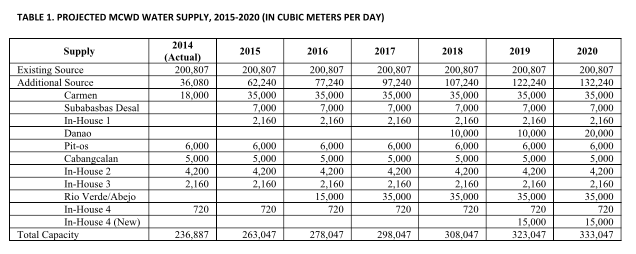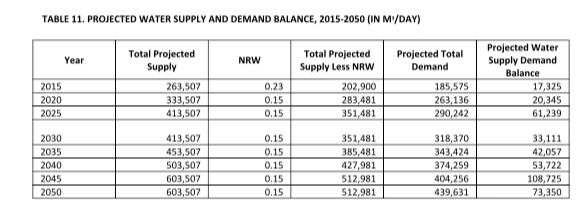The travails of MCWD: Part 2
It was shown in my 2015 study that in 2014 MCWD had a capacity of producing 236,887 cubic meters of water per day from its own sources and from contracted bulk supply. This was projected to reach 333,047 cubic meters per day by 2020. The increase in supply was to come mainly from contracted bulk suppliers or developed in-house as shown in Table 1.
In the same year 2014, total water demand In MCWD’s service area was estimated at 370,617 cubic meters per day in its service. However, MCWD was expected to serve only 169,558 cubic meters per day or 46.0 percent of this total demand. The total demand for water was projected to rise in 2020 to 416,417 cubic meters per day out of which MCWD expected to cover 63 percent.
During my study in 2015, it was also revealed that after 2020 MCWD aimed to get new additional supply of water mainly from surface water sources to meet its increasing demand from the following sources:
- Mananga Dam, 2021 – 80,000 m3/day
- Malubog Dam, 2032 – 40,000 m3/day
- Kotkot Dam, 2036 – 50,000 m3/day
- Lusaran Dam, 2041 – 100,000 m3/day
Assuming therefore that MCWD’s plans to get new sources of water supply are built and start operation in the years as indicated above, the projected water supply and demand balance within in its service area will be on the positive side from 2020 to 2050.
By 2050, surface water sources within and near the MCWD service area shall have been fully exploited. After 2050, therefore, the increasing demand for water can only be met by either of the following method:
Pumping more water from underground both within and in the areas north and south of MWCD service area – This will further reduce the ground supply as rate of extraction exceeds rate of recharge with dire consequences.
Desalination – This also requires some sophisticated equipment and a lot of power to do but new development in desalination technology may offset these drawbacks.
Construction of water dam Inabanga River in Bohol and piping its water to Cebu across Bohol Channel – This is going to be very formidable in terms of cost and technology.
So far so good if all the figures were true and its plans were executed as revealed by MCWD in my 2015 study.
The problem is that things got awry in the last four years leading to more people complaining of the inability of MCWD to service their need for water. Hence, the current brouhaha, which ended up with the City Mayor of Cebu deciding to fire the board of the MCWD, based on his power to appoint them under the existing set up.
For one, the projected utilization of Mananga Dam to produce 80,000 cubic meters per day is nowhere in sight. Meanwhile the population of Metro Cebu has been increasing rapidly, leading to more demand for water.
The point is that MCWD is had been relying mainly on bulk suppliers in the last five years to meet the increasing demand for water in its service area. It was not doing much to prepare the implementation of the four identified new sources of surface water, starting with the Mananga Dam, which was supposed to be operational in 2021.
Disclaimer: The comments uploaded on this site do not necessarily represent or reflect the views of management and owner of Cebudailynews. We reserve the right to exclude comments that we deem to be inconsistent with our editorial standards.




